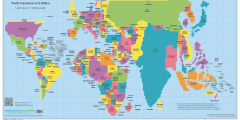The following are the sources for countries’ populations and names on the large map of population at 8 billion:
- United Nations, Department of Economic and Social Affairs, Population Division (2022). World Population Prospects 2022, Online Edition. Retrieved Nov 1, 2022 from https://population.un.org/wpp/Download/Standard/Population/
- Statistics Netherlands, StatLine. Caribbean Netherlands; population; gender, age, marital status. Retrieved Nov 1, 2022 from https://opendata.cbs.nl/statline/#/CBS/nl/dataset/83698NED/table?ts=1578654405817
- Awad, Ole. (2022, Jan 3). Brief Report on the Population of Palestine at the End of 2021. Palestinian Central Bureau of Statistics. Retrieved from https://arabcenterdc.org/resource/brief-report-on-the-population-of-palestine-at-the-end-of-2021/
The population data on the small maps of historic population over time comes from Our World in Data. The following are the primary sources for the historic population data:
- 5,000 BCE – 1799: Historical estimates by HYDE (v3.2). https://dataportaal.pbl.nl/downloads/HYDE/
- 1800 – 1949: Gapminder. Population. Documentation – version 7. https://www.gapminder.org/data/documentation/gd003/
- 1950 – 2100: United Nations, Department of Economic and Social Affairs, Population Division (2022). World Population Prospects 2022, Online Edition. https://population.un.org/wpp/Download/Standard/Population/
- 2022-2100 projections are based on the UN’s Medium variant






